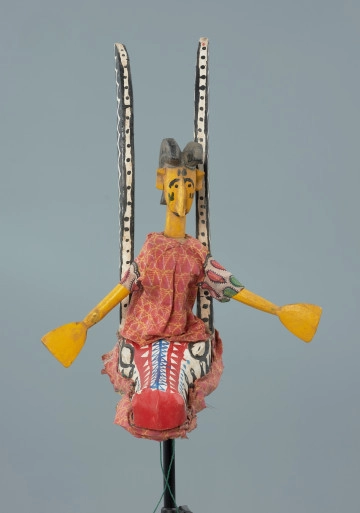
Theatre puppet: Yayoroba
między 1951 — 1984
National Museum in Szczecin
Part of the collection: Dolls from the sogo bò theater
The theatrical puppet (English: marionette, French: marionnette) of the maani type, with arms that move at the shoulders and elbows, animated from below by a puppeteer with strings, dances on the so-called mobile stage. It is part of the Sogo bò theatrical tradition in the Ségou region, in the south-central part of the Republic of Mali, organised by Kamalen Ton, i.e. village youth associations. The puppet represents a woman from the nomadic Fulbe people.The repertoire of the Sogo bò theatre is vibrant. There are forest and water animals, mythical and fantastic creatures. There is also a range of characters typical for Mali society: farmers, fishermen, hunters, musicians, blacksmiths, weavers, representatives of neighbouring peoples, administrative authorities, women and men performing everyday activities. Puppets representing women from groups neighbouring Bozo (Marka, Bamana and Fulbe) can be recognised by a characteristic element of clothing, hairstyle or prop. The most popular among them is the figure of Fula Mùso, a symbol of physical perfection but also the embodiment of an unfaithful, flirtatious and playful woman. The red colour used to paint the doll emphasises her dangerous character, especially for men.Fulbe women are famous throughout West Africa for their beauty and elegance. They have developed a sophisticated art of decorating their bodies with perfect hairstyles, henna drawings and jewellery. They are admired for their fair complexion, long hair and delicate facial features. The appearance of the character Fula Mùso in the repertoire of Sogo bò theatre allows the public to raise the subject of seduction and relationships between men and women. The puppet is a gift from Oleńka Darkowska-Nidzgorska and Denis Nidzgorski-Gordier.
Ewa Prądzyńska
Author / creator
Dimensions
cały obiekt: height: 80,5 cm, width: 21,5 cm
Object type
puppet
Creation time / dating
Creation / finding place
Identification number
Location / status

unknown
między 1951 — 1984
National Museum in Szczecin

unknown
między 1901 — 1950
National Museum in Szczecin

unknown
między 1951 — 1969
National Museum in Szczecin
DISCOVER this TOPIC
National Museum in Szczecin
DISCOVER this PATH
Educational path
0/500

We use cookies to make it easier for you to use our website and for statistical purposes. You can manage cookies by changing the settings of your web browser. More information in the Privacy Policy.
We use cookies to make it easier for you to use our website and for statistical purposes. You can manage cookies by changing the settings of your web browser. More information in the Privacy Policy.
Manage cookies:
This type of cookies is necessary for the website to function. You can change your browser settings to block them, but then the website will not work properly.
WYMAGANE
They are used to measure user engagement and generate statistics about the website to better understand how it is used. If you block this type of cookies, we will not be able to collect information about the use of the website and we will not be able to monitor its performance.